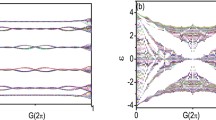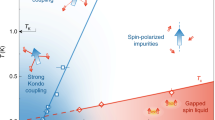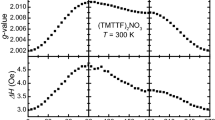Abstract
Matter is excited by adding an electron or extracting one. These excitations can move in the bulk material almost like a free particle, carrying an electronic charge and spin. The electrons try to avoid each other by Coulomb repulsion and also interact magnetically. If they are confined to one dimension, charge and spin excitations are separated and move independently due to the strong interaction. The unique properties of one-dimensional systems are revealed in a number of experiments on strongly anisotropic materials. Here we review the theoretical models and the experimental indications for the unusual behavior of quasi one-dimensional organic conductors.










Similar content being viewed by others
References
Chow DS, Zamborszky F, Alavi B, Tantillo DJ, Baur A, Merlic CA, Brown SE (2000) Charge ordering in the TMTTF family of molecular conductors. Phys Rev Lett 85:1698–1701
Claessen R, Sing M, Schingenschlögl U, Blaha P, Dressel M, Jacobsen CS (2002) Spectroscopic signatures of spin-charge separation in the quasi-one-dimensional organic conductor TTF-TCNQ. Phys Rev Lett 88:096401–1-4
Clay RT, Mazumdar S, Cambell DK (2003) Pattern of charge ordering in quasi-one-dimensional organic charge-transfer solids. Phys Rev B 67:115121–1-9
Dardel B, Malterre D, Grioni M, Weibel P, Baer Y, Voit J, Jérome D (1993) Possible observation of a Luttinger-liquid behaviour from photoemission spectroscopy of one-dimensional organic conductors. Europhys Lett 24:687–692
Dressel M, Grüner G (2002) Electrodynamics of solids. Cambridge University Press, Cambridge
Dressel M, Schwartz A, Grüner G, Degiorgi L (1996) Deviations from Drude response in low-dimensional metals: electrodynamics of the metallic state of (TMTSF)2 PF6. Phys Rev Lett 77:398–401
Dressel M, Kirchner S, Hesse P, Untereiner G, Dumm M, Hemberger J, Loidl A, Montgomery L (2001) Spin and charge dynamics in Bechgaard salts. Synth Metals 120:719–720
Dumm M, Loidl A, Fravel BW, Starkey KP, Montgomery L, Dressel M (2000) Electron-spin-resonance studies on the organic linear chain compounds (TMTCF) 2 X (C =S, Se and X =\( {{\rm{PF}}_{{\rm{6}}} } \), \( {{\rm{AsF}}_{{\rm{6}}} } \), \( {{\rm{ClO}}_{{\rm{4}}} } \), Br). Phys Rev B 61:511–520
Farges JP (ed) (1994) Organic conductors. Dekker, New York
Giamarchi T (1991) Umklapp process and resistivity in one-dimensional fermion systems. Phys Rev B 33:2905–2913
Giamarchi T (1997) Mott transition in one dimension. Physica B 230–232:975–980
Giamarchi T, Millis AJ (1992) Conductivity of a Luttinger liquid. Phys Rev B 46:9325–9331
Haldene FDM (1981) Luttiner liquid theory of one-dimensional quantum fluids. I. Properties of the Luttinger model and their extension to the general 1D interacting spinless Fermi gas. J Phys C 14:2585–2609
Ishiguro T, Yamaji K Saito G (1998) Organic superconductors, 2nd edn. Springer, Berlin Heidelberg New York
Jérome D (1991) The physics of organic conductors. Science 252:1509–1514
Jérome D, Schulz HJ (1982) Organic conductors and superconductors. Adv Phys 31:299–490
Jérome D, Mazaud A, Ribault M, Bechgaard K (1980) Superconductivity in a Synthetic Organic Conductors (TMTSF)2PF6. J Phys Lett 41:L95–98
Landau LD (1957) The theory of a Fermi liquid. Sov Phys JETP 3:920–925
Lorenz T, Hofmann M, Grüninger M, Freimuth A, Uhrig GS, Dumm M, Dressel M (2002) Evidence for spin-charge separation in quasi one-dimensional organic conductors. Nature 418:614–617
Luttinger JM (1963) An exactly solvable model of a many-fermion system. J Math Phys 4:1154–1162
Monceau P (ed) (1985) Electronic properties of inorganic quasi-one-dimensional compounds, part I/II. Reidel, Dordrecht
Monceau P, Nad FY, Brazovskii S (2001) Ferroelectric Mott-Hubbard phase of organic (TMTTF) 2 X conductors. Phys Rev Lett 86:4080–4083
Moser J, Gabay M, Auban-Senzier P, Jérome D, Bechgaard K, Fabre JM (1998) Transverse transport in (TM) 2 X organic conductors: possible evidence for a Luttinger liquid. Eur Phys J B 1:39–46
Pines D, Nozières P (1966) The theory of quantum liquids, vol 1. Addison-Wesley, Reading
Schwartz A, Dressel M, Grüner G, Vescoli V, Degiorgi L, Giarmarchi T (1998) On-chain electrodynamics of metallic (TMTSF)2 X salts: observation of Tomonaga-Luttinger liquid response. Phys Rev B 58:1261–1271
Shibata Y, Nishimoto S, Ohta Y (2001) Charge ordering in the one-dimensional extended Hubbard model: implications to the TMTTF family of organic conductors. Phys Rev B 64:235107–1-5
Tomonaga S (1950) Remarks on Bloch's method of sound waves applied to many-fermion problems. Prog Theor Phys Kyoto 5:544–569
Vescoli V, Degiorgi L, Henderson W, Grüner G, Starkey KP, Montgomery LK (1998) Dimensionality-driven insulator-to-metal transition in the Bechgaard salts. Science 281:1181−1184
Voit J (1995) One-dimensional Fermi liquids. Rep Prog Phys 58:977–1116
Wzietek P, Creuzet F, Bourbonnais C, Jérome D, Bechgaard K, Batail P (1993) Nuclear relaxation and electronic correlations in quasi-one-dimensional organic conductors. II. Experiments. J Phys I Paris 3:171–200
Zamborszky F, Yu W, Raas W, Brown SE, Alavi B, Merlic CA, Baur A (2002) Competition and coexistence of bond and charge orders in (TMTTF)2 AsF6. Phys Rev B 66:081103–081106
Acknowledgements
During the past few years, we have enjoyed collaborations and discussions with R. Claessen, L. Degiorgi, M. Dumm, A. Freimuth, G. Grüner, and J. Voit.
Author information
Authors and Affiliations
Corresponding author
Rights and permissions
About this article
Cite this article
Dressel, M. Spin-charge separation in quasi one-dimensional organic conductors. Naturwissenschaften 90, 337–344 (2003). https://doi.org/10.1007/s00114-003-0438-z
Published:
Issue Date:
DOI: https://doi.org/10.1007/s00114-003-0438-z




